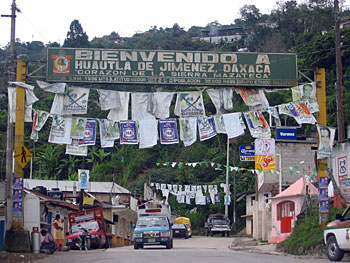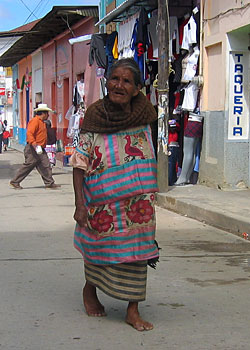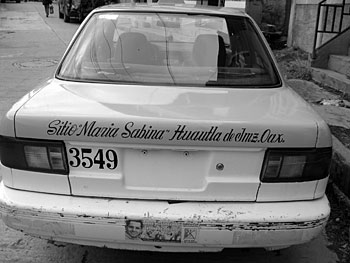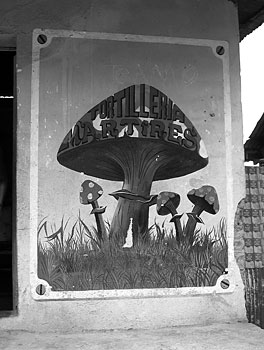A Journey to Huautla
The Cacaphonous Crossroads Between Old and New
Nov 2004
Citation: Erowid F, Erowid E. "A Journey to Huautla: The Cacaphonous Crossroads Between Old and New." Erowid Extracts. Nov 2004;7:20-21.
Huautla de Jiménez is best known as the Mexican town where R. Gordon Wasson re-discovered
the indigenous use of psilocybin mushrooms in the mid-1950s. In a ceremony led by María
Sabina, now one of Mexico's most famous curanderas, Wasson confirmed speculation that the mushrooms
used were powerfully psychoactive. Both he and the local Mazatec people gained world-wide notoriety
when his experience was published in a groundbreaking Life Magazine article in 1957.
Part of the reason we wanted to attend the Mind States conference in Oaxaca was for the chance to travel to Huautla. We were particularly interested in getting a sense of the town and what the impact had been of 47 years of entheo-tourism.
Secondary aspirations included enjoying the mountain scenery, talking to locals about Salvia
divinorum, meeting people who use psilocybin mushrooms as part of a local healing tradition, and,
if everything worked out, possibly participating in a traditional ceremony.
Although our group of four had concerns about the potential impact of our own entheotourism, faced with the (jarring) reality of Mexico, those concerns seemed oversensitive. Looking back now, as mycophiles and drug geeks, our fate was sealed from the moment we made our reservations to fly to Oaxaca; we decided to take the plunge and make our pilgrimage to Huautla.
It was a beautiful drive through small villages and varied terrain, including steep desert hills covered in magnificent cacti overlooking a verdant river valley.
To reach Huautla, we ascended from the valley up into the high Sierra Madre mountains. Before we set out, we'd been warned about how dangerous the road to Huautla was, but we found it paved and in good repair. As we climbed, we entered the clouds that had been obscuring the mountain peaks. The environment changed immediately into lush, green cloud-forest. Small waterfalls splashed onto the road as we wound our way past thatch-roofed cinder block homes and metal-topped wooden shacks. Plots of maize, precariously farmed on the steep hillsides, were the most obvious sign of local industry.
The drive had a magical quality, as we had no idea what would be around each bend: new vistas,
rustic towns, novel plant life, grazing donkeys and other majestic features abounded. Locals walked
along the road carrying loads of wood, herding goats, or leading burros as they worked. Women wore
colorful dresses with their hair tied up in functional, decorative ribbons. We determined along the
way that the power animal for our journey must be the donkey, as it appeared everywhere we went: we
knew we were on the right path if there was a donkey in view.
From the moment we arrived in Huautla, we were confronted with images of María Sabina and mushrooms in both commercial and residential settings, from the very cheesy to the sincere. As we sat in the blocked traffic on a one-lane street heading towards the town center, we noticed that the local taxis all bore María Sabina's name on their trunks. T-shirts with a low-quality photo of María Sabina hung outside storefronts, as did shirts and dresses with hand- embroidered mushroom adornments. Building walls were painted with brightly colored mushrooms.
It wasn't clear to our little group whether we had come at a particularly raucous time or whether it was always this noisy. The central market overflowed with the stalls and tables of locals selling vegetables, crafts, and miscellaneous products. A bank overlooking the market had a huge, overdriven stereo system set up in front blasting shockingly-loud, harsh, Mexican techno-music; bank employees accompanied this by honking the horn of a pickup truck (almost) in time with the beat. Much to our chagrin, the recommended hotel, El Rinconcito, was directly adjacent to the repellant bank and, in an error that defined our stay in Huautla, we believed the hotel manager's claim that the music would end soon.
Fleeing the din, we ran into friends from the recent Mind States conference. We shared stories of
mushroom encounters and discussed contacts that had been made with local curanderas. The rumor was
that mushroom season was mostly over and the available mushrooms were weak and in limited supply.
One friend described asking to buy hongos and being shown moldy mushrooms that had decomposed past
any chance of identification to a point where they would NEVER eat them. Others described receiving
promises that if they paid now, they could come back the next day to collect the mushrooms.
We spoke to several Norte Americanos who had already taken part in ceremonies, with mixed results. One described a wonderful, healing experience with a sense of connection to a deep local tradition. Another described being underdosed and having an unsettling evening while acquaintances (not taking part in the ceremony) watched.
After another failed attempt to brave the nerve-shattering music outside our hotel, we decided to wander up the steep hillside of the town, away from the market. The further we got from the center of town, the more friendly and open the people of Huautla became. A man in his mid 50s gregariously attempted to teach us basic words and vulgar greetings in Náhuatl. We passed beautiful gardens with flower-heavy Brugmansia and morning glory before eventually finding a quiet spot that served us beer and toasted squash seeds on a patio overlooking the town and valley below.
We spent the evening embroiled in a goose chase that seemed like it might be common for the ceremony seeker in Huautla: find person X to get an introduction to person Y who person Z said is a good curandero. The chase was colored by the fact that a couple of documentary filmmakers were in town trying to get footage of a traditional mushroom healing ceremony. They had filmed a young healer running a ceremony for a gringo the night before, and the healer was now having second thoughts. We happened to be standing nearby when he confronted the filmmakers, saying he no longer gave his permission for the footage to be used.
At this point, our priorities shifted and we focused on finding someone to talk with about Salvia
divinorum. We wondered what the surge in worldwide popularity had meant for the plant in Huautla.
Had it increased attention from the tourist trade or the government? One man told us that, earlier
in 2004, the army had carried out a S. divinorum eradication program in the mountains around
Huautla. We were unable to find anyone else who could confirm or deny this rumor.
We finally got word that the curandera who had been recommended was out of town that week. It became obvious that we could find opportunities to participate in mushroom ceremonies, and might even be able to find a curandera with knowledge of S. divinorum, but to do this in the three days we had available would require forceful pushing on our part. Everything that had happened since we arrived in Huautla was sending the message that we should let go of the idea of finding a traditional curandera. We made the decision not to force things, and said no to the nice man who wanted to charge us $100 (USD) to chat with him about mushrooms.
The distinct lesson we learned was that staying in the center of town for just a couple of days was not the way to experience the heart of Huautla, and arriving cold, without much information or any acquaintances, made it difficult to do our research in the right spirit. The tide of other travelers who had preceded us that week, along with the short duration of our stay, had made it easy to find the omnipresent, crass side of the local mushroom culture--from the hotel keychain in the shape of a mushroom, to the busts of María Sabina for sale in the lobby--but somewhat difficult to find the spiritual and traditional side. If we returned, we would try to make contacts before we arrived, or would plan on spending a full week or more to allow time to develop connections.
We felt we were successful in achieving our primary goal, that of getting a taste of modern Huautla. Unfortunately, the rest of our goals went unfulfilled. It may have been the wrong time and circumstances for us to explore more deeply, but we look forward to another visit. As we left Huautla, we all breathed a sigh of relief as the weight of the town lifted, and the beautiful countryside engulfed our attention.
Remote, yet on a paved road with highspeed internet; sacred, yet burdened by the profane--Huautla remains a bridge between the traditions of spirit and the realities of modern life, with all the attendant difficulties and rough edges that seem somehow fitting for the home of the mushroom.
Part of the reason we wanted to attend the Mind States conference in Oaxaca was for the chance to travel to Huautla. We were particularly interested in getting a sense of the town and what the impact had been of 47 years of entheo-tourism.

|
Although our group of four had concerns about the potential impact of our own entheotourism, faced with the (jarring) reality of Mexico, those concerns seemed oversensitive. Looking back now, as mycophiles and drug geeks, our fate was sealed from the moment we made our reservations to fly to Oaxaca; we decided to take the plunge and make our pilgrimage to Huautla.
The Journey#
Huautla is a little over six hours drive north of Oaxaca City. Once outside of the city, the road
quickly turns into a two lane highway with almost no identifying street signs. Following our
terrible map--the butt of non-stop jokes for our overtired crew--turned out to be a challenge. We
spent the first several hours of the trip with only a general sense of whether or not we were on
the correct road: sometimes we were and sometimes we weren't (Yes, you need to take a hard right
before Heitzo and drive through that little town to get on 135 north!).It was a beautiful drive through small villages and varied terrain, including steep desert hills covered in magnificent cacti overlooking a verdant river valley.
To reach Huautla, we ascended from the valley up into the high Sierra Madre mountains. Before we set out, we'd been warned about how dangerous the road to Huautla was, but we found it paved and in good repair. As we climbed, we entered the clouds that had been obscuring the mountain peaks. The environment changed immediately into lush, green cloud-forest. Small waterfalls splashed onto the road as we wound our way past thatch-roofed cinder block homes and metal-topped wooden shacks. Plots of maize, precariously farmed on the steep hillsides, were the most obvious sign of local industry.

|
Our Arrival#
The enchanting drive had us all in a mellow mood as we arrived at our destination. Unfortunately,
that mood didn't last. Huautla is a somewhat remote, rural town that has attracted a lot of outside
attention and tourism because of one small part of its cultural heritage. Though we had spoken with
several people who had been to Huautla, we had only the vaguest expectations of what the historic
town would be like. To us gringos, it felt surprisingly like a low rent boom-town built on
psychoactive tourism. Immediately after stepping out of our car, we were offered hongos
(psychedelic mushrooms) by an elderly gentleman. It turned out to be only the first of many such
encounters; the rest of our stay was punctuated by frequent offers by all manner of locals, from a
six-year-old girl to an elderly woman. Men and women of every age matched steps with us in the
street to make their offer or shouted to us from balconies as we passed by.From the moment we arrived in Huautla, we were confronted with images of María Sabina and mushrooms in both commercial and residential settings, from the very cheesy to the sincere. As we sat in the blocked traffic on a one-lane street heading towards the town center, we noticed that the local taxis all bore María Sabina's name on their trunks. T-shirts with a low-quality photo of María Sabina hung outside storefronts, as did shirts and dresses with hand- embroidered mushroom adornments. Building walls were painted with brightly colored mushrooms.
It wasn't clear to our little group whether we had come at a particularly raucous time or whether it was always this noisy. The central market overflowed with the stalls and tables of locals selling vegetables, crafts, and miscellaneous products. A bank overlooking the market had a huge, overdriven stereo system set up in front blasting shockingly-loud, harsh, Mexican techno-music; bank employees accompanied this by honking the horn of a pickup truck (almost) in time with the beat. Much to our chagrin, the recommended hotel, El Rinconcito, was directly adjacent to the repellant bank and, in an error that defined our stay in Huautla, we believed the hotel manager's claim that the music would end soon.

|
We spoke to several Norte Americanos who had already taken part in ceremonies, with mixed results. One described a wonderful, healing experience with a sense of connection to a deep local tradition. Another described being underdosed and having an unsettling evening while acquaintances (not taking part in the ceremony) watched.
After another failed attempt to brave the nerve-shattering music outside our hotel, we decided to wander up the steep hillside of the town, away from the market. The further we got from the center of town, the more friendly and open the people of Huautla became. A man in his mid 50s gregariously attempted to teach us basic words and vulgar greetings in Náhuatl. We passed beautiful gardens with flower-heavy Brugmansia and morning glory before eventually finding a quiet spot that served us beer and toasted squash seeds on a patio overlooking the town and valley below.
We spent the evening embroiled in a goose chase that seemed like it might be common for the ceremony seeker in Huautla: find person X to get an introduction to person Y who person Z said is a good curandero. The chase was colored by the fact that a couple of documentary filmmakers were in town trying to get footage of a traditional mushroom healing ceremony. They had filmed a young healer running a ceremony for a gringo the night before, and the healer was now having second thoughts. We happened to be standing nearby when he confronted the filmmakers, saying he no longer gave his permission for the footage to be used.

|
We finally got word that the curandera who had been recommended was out of town that week. It became obvious that we could find opportunities to participate in mushroom ceremonies, and might even be able to find a curandera with knowledge of S. divinorum, but to do this in the three days we had available would require forceful pushing on our part. Everything that had happened since we arrived in Huautla was sending the message that we should let go of the idea of finding a traditional curandera. We made the decision not to force things, and said no to the nice man who wanted to charge us $100 (USD) to chat with him about mushrooms.
The distinct lesson we learned was that staying in the center of town for just a couple of days was not the way to experience the heart of Huautla, and arriving cold, without much information or any acquaintances, made it difficult to do our research in the right spirit. The tide of other travelers who had preceded us that week, along with the short duration of our stay, had made it easy to find the omnipresent, crass side of the local mushroom culture--from the hotel keychain in the shape of a mushroom, to the busts of María Sabina for sale in the lobby--but somewhat difficult to find the spiritual and traditional side. If we returned, we would try to make contacts before we arrived, or would plan on spending a full week or more to allow time to develop connections.
We felt we were successful in achieving our primary goal, that of getting a taste of modern Huautla. Unfortunately, the rest of our goals went unfulfilled. It may have been the wrong time and circumstances for us to explore more deeply, but we look forward to another visit. As we left Huautla, we all breathed a sigh of relief as the weight of the town lifted, and the beautiful countryside engulfed our attention.
Remote, yet on a paved road with highspeed internet; sacred, yet burdened by the profane--Huautla remains a bridge between the traditions of spirit and the realities of modern life, with all the attendant difficulties and rough edges that seem somehow fitting for the home of the mushroom.

